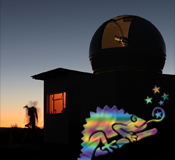 |
CHAMÄLEON + ONJALA OBSERVATORY DeepSky | SITEMAP HOME CHAMÄLEON |
|
 |
|||
| « zurück zur Startseite
galaktische Nebel « back to home galactic nebula |
Großes Bild laden - load large
image 2048 x
1400 Pixel Aufnahmedaten Image data |
Herschel's Keyhole Nebula - the center of the great Carina Nebula
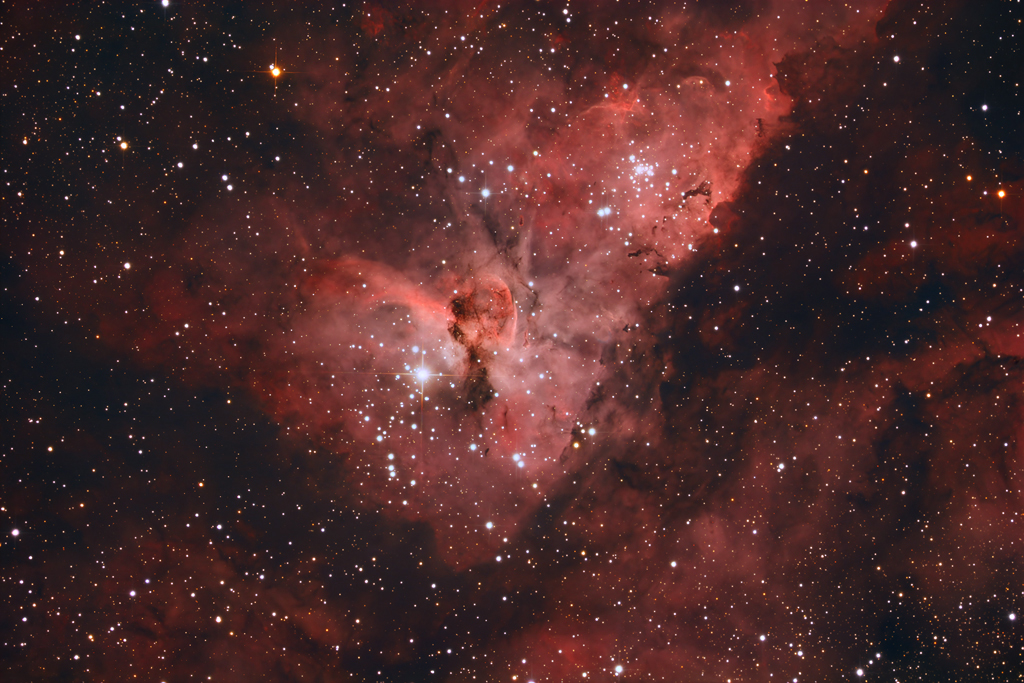
Herschels Schlüssellochnebel- Unser Bild zeigt den so genannten Schlüssellochnebel in hoher Bildauflösung. Zusammen mit dem exotischen Sternsystem Eta Carina steht er im Zentrum des großen Carinanebels NGC 3372. Er ist eines der größten und hellsten Sternentstehungsregionen am Himmel und wir sehen ihn in einer Entfernung von etwa 7.500 Lichtjahren. Er erstreckt sich über ungefähr 260 Lichtjahre quer durch die südliche Milchstraße und ist - selbst bei Mondlicht - mit bloßem Auge deutlich sichtbar. Weiterhin zeigt unser Bild 3 sehr junge offene Sternhaufen: Trumpler 16 mit Eta Carinae im Zentrum, Trumpler 14 rechts oberhalb der Bildmitte und östlich (links im Bild) Collinder 232.
Die Nebelregion im Sternbild Carina (Kiel des Schiffs) wurde im Jahr 1751 von dem französischen Astronomen Abbé Nicolas de Lacaille vom Kap der Guten Hoffnung aus entdeckt, bzw. erstmalig ausführlich beschrieben worden. Bei einer Beobachtung mit leistungsfähigen Amateurteleskopen zeigt er sich reich an einer erstaunlichen Vielfalt kleinerer Strukturen wie z.B. dem Schlüssellochnebel und zahlreichen hellen und dunklen kugelförmigen Strukturen sowie Staubsäulen und viele offene Sternhaufen.
Herschels Schlüssellochnebel ist eine kleinere, dunkle Region mit einem äußeren Rand aus hell leuchtenden Fäden und einem Durchmesser von etwa 7 Lichtjahren. Die Struktur in Form eines Schlüssellochs wurde durch einen Ausbruch des rätselhaften, Hyperriesensterns Eta Carinae geformt. Seine ungewöhnliche Form hebt sich vor dem helleren Nebel im Hintergrund ab, wodurch die namens gebende Gestalt entsteht. Das Schlüsselloch wurde von dem englischen Astronomen Sir John Herschel im 19. Jahrhundert benannt, zu einer Zeit als Eta Carinae einer der hellsten Sterne am Himmel war und die Form des Schlüssellochs vollständig beleuchtet wurde. Heute ist Eta Carinae kaum noch mit bloßem Auge zu erkennen und das Schlüsselloch ist viel weniger ausgeprägt.
Ausführliche Informationen zum Eta Carinae Sternsystem sowie zu historischen Beobachtungen zum Schlüssellochnebel finden Sie hier.
Object description
Herschel's Keyhole Nebula -Our image shows the so-called Keyhole Nebula in high resolution. Together with the exotic star system Eta Carina, it is at the center of the large Carina Nebula NGC 3372, one of the largest and brightest star-forming regions in the sky, and we can see it at a distance of about 7,500 light years. It stretches for about 260 light years across the southern Milky Way and is clearly visible to the naked eye - even in moonlight. Our image also shows 3 very young open star clusters: Trumpler 16 with Eta Carinae in the center, Trumpler 14 to the right above the center of the image and Collinder 232 to the east (left of the image).
The nebula region in the constellation Carina (keel of the ship) was discovered and first described in detail in 1751 by the French astronomer Abbé Nicolas de Lacaille from the Cape of Good Hope. When observed with powerful amateur telescopes, it is rich in an astonishing variety of smaller structures such as the Keyhole Nebula and numerous bright and dark spherical structures as well as dust columns and many open star clusters.
Herschel's Keyhole Nebula is a smaller, dark region with an outer rim of brightly glowing filaments and a diameter of about 7 light years. The keyhole-shaped structure was formed by an eruption of the enigmatic hypergiant star Eta Carinae. Its unusual shape stands out against the brighter nebula in the background, giving it its name. The keyhole was named by the English astronomer Sir John Herschel in the 19th century, at a time when Eta Carinae was one of the brightest stars in the sky and the shape of the keyhole was fully illuminated. Today, Eta Carinae is barely visible to the naked eye and the keyhole is much less pronounced.
Detailed information on the Eta Carinae star system and historical observations of the Keyhole Nebula can be found here.
Herschel's Keyhole Nebula - the center of the great Carina Nebula
Image data
13.05.2022 - 12 x 300 s, QHY ALccd 12 (cooled)
Telescope: PlaneWave CDK 12.5" Astrograph + 0.8x Reducer at f = 2030 mmm
Location: Chamäleon Observatory, Onjala Lodge, Namibia
Image acquisition and processing: DeepSkyStacker, PixInsight + Photoshop by Bernd Gooßmann
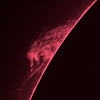 |
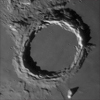 |
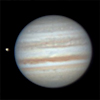 |
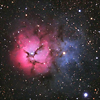 |
 |
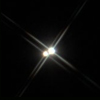 |
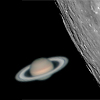 |
| Sonne | Mond | Sonnensystem | DeepSky | Weitwinkel | Verschiedenes | Spez. Projekte |